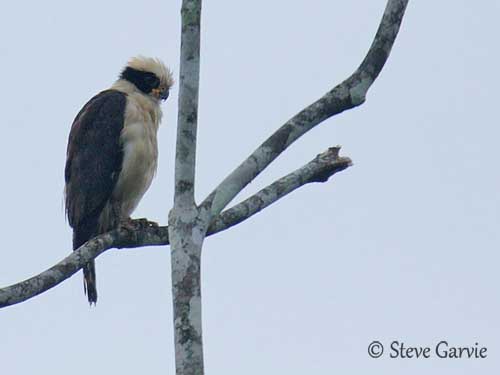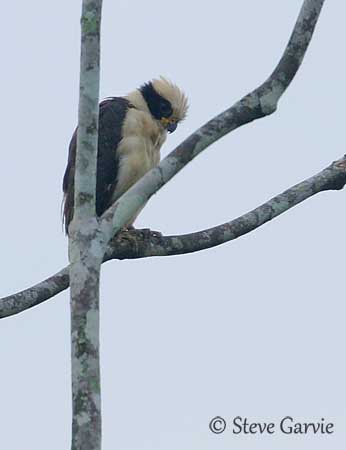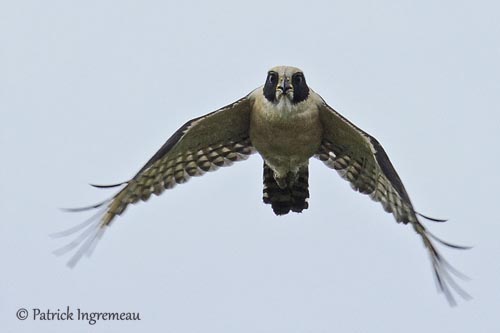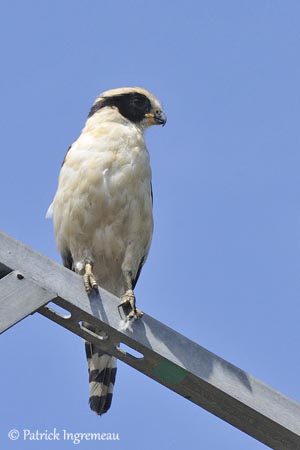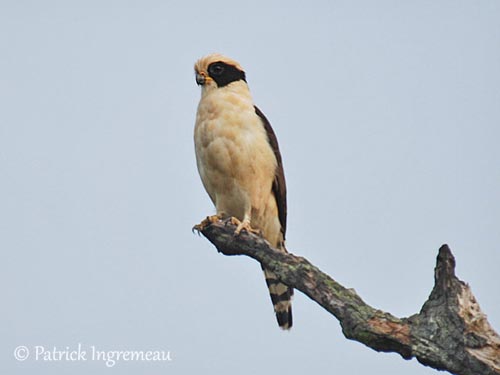
Laughing Falcon
Herpetotheres cachinnans
Falconiforme Order – Falconidae Family
BIOMETRICS:
Length: 46-56 cm
Wingspan: 79-94 cm
Weight: M : 565-685 g – F : 625-800 g
LONGEVITY : up to 14 years
DESCRIPTION:
Laughing Falcon is a dark and white bird of prey, also named Snake Hawk because it is a snake-eater. It has relatively short, rounded wings, and long barred tail.
Adult male has dark brown upperparts. In flight, wings are dark brown with broad cinnamon patch at base of primaries flight feathers. Tail is blackish, barred with four to five buffy-white bands. Tip is whitish.
Underparts are entirely creamy-white to buffy-white. Underwings are buffy-white to pale rufous, with sparse dark brown spots. Flight feathers are barred brown. Undertail feathers are blackish, barred with three to four buffy-white bands.
Plumage varies with individual.
On the large head, forehead, crown and neck are buffy-white. A broad, dark brown to blackish mask from lores to nape, includes eyes and cheeks. Crown can be slightly streaked with brown.
Eyes are dark brown. Hooked bill is black with yellow cere. Legs and feet are yellow. Tarsi are powerful and feet show short toes, very typical of birds of prey hunting snakes.
Both sexes are similar, with female slightly larger than male.
Immature shows rufous or buff edges on back and wings. Underparts are rather white, and thighs are spotted rufous or buff.
We can find three subspecies, living from Mexico, through Central America to northern half of South America.
H.c. chapmani, H.c. cachinnans and H.c. queribundus differ in size and intensity of plumage colours.
VOICE: SOUNDS BY XENO-CANTO
Laughing Falcon utters a far-carrying laughing when it is disturbed “wah wah” or “w’hah w’hah” repeated. This series resembles human cries, rising and falling abruptly. Laughing Falcon also gives longer “ha-cow, ha-cow” and a kind of maniacal laugh “ha-cah ha ha-cah”. Softer “ha” and “hah” are irregularly repeated.
Two birds can perform duets, each bird calling at different pitches and rhythms.
HABITAT:
Laughing Falcon is common in open forest and edges, palm savannah and second growth. It frequents clumps of trees along rivers, and it is often seen near clearings and tracks.
RANGE:
Laughing Falcon lives from Mexico, through Central America to South America where it is found in Peru and Bolivia in Amazonian regions, in Brazil and northern Argentina. It is visible up to 1500 metres of elevation, but up to 2400 metres in Colombia.
BEHAVIOUR:
Laughing Falcon feeds primarily on terrestrial or arboreal snakes. Its preys can be large and venomous snakes, and several kinds of snakes. It also hunts lizards and rodents in cultivated areas, and sometimes fish.
Laughing Falcon hunts from exposed perch from where it can have good visibility. When it is waiting for prey, it remains perched with bowed head, looking at the ground. It pounces on a snake very strongly, and holds it with the bill just behind the head which is usually removed.
Prey is eaten on a branch. Laughing Falcon carries small snakes in the bill, but larger preys are taken with talons and carried parallel to the body, as an Osprey with a fish. According to the size of the prey, it swallows it tail first or into pieces. It sometimes takes bats. It is mainly active at dawn and dusk.
Laughing Falcon is mainly sedentary, sometimes performing some seasonal movements.
Male uses its laughing call for attracting females. Pairs can perform duets during several minutes at dusk and dawn. It defends its territory.
FLIGHT:
Laughing Falcon flies slowly but with rapid shallow wing beats. This species does not soar.
REPRODUCTION:
Breeding season varies according to the latitude.
Laughing Falcon is probably monogamous and solitary nester.
This species nests in cavities in trees or cliffs, up to 30 metres above the ground. It can use abandoned stick nests. Nest-site is often isolated from surrounding vegetation, and can be situated in very tall tree above the canopy. Loud duets are performed close to the nest by both mates, mainly at dawn and dusk. Pair often roosts near the potential nest-site.
Female usually lays one whitish or pale buff egg with dark brown markings. Incubation lasts about 45 to 50 days, by female.
Chick is covered in pale buffy brown down, darker on upperparts, and we can see a dark facial mask.
Female feeds the chick with the food brought at nest by the male. Young fledges about eight weeks after hatching. Parents still fed the young, but one month later, they decrease slowly to feed it which is forced to leave the nest in order to find food itself.
DIET:
Laughing Falcon feeds mainly on snakes, but it also takes lizards, rodents and fish, and sometimes bats when they leave their roosts at dusk.
PROTECTION / THREATS / STATUS:
Laughing Falcon populations are not globally threatened at this moment. These raptors are fairly common within their range.
Fr: Macagua rieur
All: Lachfalke
Esp: Halcón Reidor
Ital: Falco sghignazzante
Nd: Lachvalk
Russe: Смеющийся сокол
Photographs of the perched birds by Steve Garvie
His website: RAINBIRDER Photo galleries
Photo of the flying bird by Patrick Ingremeau
His website: TAMANDUA
Text by Nicole Bouglouan
Sources:
HANDBOOK OF THE BIRDS OF THE WORLD Vol 2 by Josep del Hoyo-Andrew Elliot-Jordi Sargatal - Lynx Edicions - ISBN: 8487334156
A GUIDE TO THE BIRDS OF COLOMBIA by Steven L. Hilty and William L. Brown
Princeton University Press – ISBN 069108372X
A GUIDE TO THE BIRDS OF MEXICO AND NORTHERN CENTRAL AMERICA by Steve N. G. Howell, Sophie Webb - Oxford University Press - ISBN: 0198540124
Animal Diversity Web (University of Michigan Museum of Zoology)
Wikipedia (Wikipedia, The Free Encyclopedia)
The Hawk Conservancy Trust (Hilary Smith)
El Zoológico Electrónico (Damisela)

